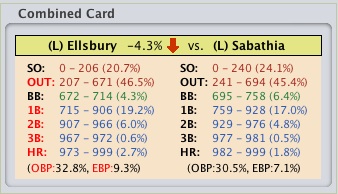How Basic Probabilities are Calculated
The simulated performance of each pitcher and batter in a library is determined by the the player's ratings (see How Ratings are Calculated) and the following six basic probabilities:
- The probability of a strike out (SO%): This represents the probability that a batter will strike out against an average pitcher, or that a pitcher will strike out an average batter. This value is calculated as SO/PA for batters and SO/BF for pitchers. This value will never be smaller than the minimum probability for a batting statistic, which is specified in the Normalize Options dialog.
- The probability of all other outs (OUT%): This represents the probability that a batter will make an out, other than a strikeout, against an average pitcher, or that a pitcher will cause an average batter to make an out other than a strikeout. This value is calculated as 1.0 - SO% + BB% + 1B% + 2B% + 3B% + HR%.
- The probability of a single (1B%): This represents the probability that a batter will get a base hit against an average pitcher, or that a pitcher will give up a base hit against an average batter. This value is calculated as 1B/PA for batters and 1B/BF for pitchers. This value will never be smaller than the minimum probability for a batting statistic, which is specified in the Normalize Options dialog.
- The probability of a double (2B%): This represents the probability that a batter will hit a double against an average pitcher, or that a pitcher will give up a double against an average batter. This value is calculated as 2B/PA for batters and (H * 2B/H), where 2B/H is specified by the current league average file (see League Averages). This value will never be smaller than the minimum probability for a batting statistic, which is specified in the Normalize Options dialog.
- The probability of a triple (3B%): This represents the probability that a batter will hit a triple against an average pitcher, or that a pitcher will give up a triple against an average batter. This value is calculated as 3B/PA for batters and (H * 3B/H), where 3B/H is specified by the current league average file (see League Averages). This value will never be smaller than the minimum probability for a batting statistic, which is specified in the Normalize Options dialog.
- The probability of a home run (HR%): This represents the probability that a batter will hit a home run against an average pitcher, or that a pitcher will give up a home run against an average batter. This value is calculated as HR/PA for batters and HR/BF for pitchers. This value will never be smaller than the minimum probability for a batting statistic, which is specified in the Normalize Options dialog.
All of these probabilities are historically normalized (see Explaining Normalization for more information).
For a batter, each event listed above represents the chance that the given event will happen to a batter against an average pitcher. For a pitcher, each event listed above represents the chance that the pitcher will allow the given event while facing an average batter. What determines an average batter or an average pitcher are the statistics located in the current league average file (see League Averages).
|
On a Player Card (see Player Cards), probabilities are displayed using a range of numbers that lie somewhere between 0 and 999. Each number inside a range represents a 0.1% chance that the event (e.g., SO, 1B) will take place. For example, if the range 0-168 appears on a batter's card for his SO%, that batter has a 16.9% chance of striking out against the average pitcher. Alternatively, if the range 0-168 appears on a pitcher's card for his SO%, that pitcher has a 16.9% chance of striking out the average batter. All of these probabilities are historically normalized (see Explaining Normalization for more information). |
 |
|
Of course, during a game batters are not typically facing average pitchers and pitchers are not typically facing average batters. To account for this, the current batter's card must be combined with the current pitcher's card to determine the probabilities resulting from the confrontation. These resulting probabilities are shown on the Combined Card. (see Player Cards). All of these probabilities are historically normalized (see Explaining Normalization for more information). |
 |
The probabilities shown on a combined card are calculated by adjusting the batter's probabilities based on how much better, or worse, the current pitcher is compared to the average pitcher (see League Averages). More specifically, Bill James's Log5 method is used. The Log5 formula used is :
Combined event probability = ((a * b) / c) / (num +
((1-a)*(1-b))/(1-c))
Where a = batter's event probability; b = pitcher's event probability; and c =
league average pitcher's event probability
Additional adjustments are made to the probabilities shown in the Combined Card based on the pitcher's and batter's handedness and on the current fatigue of the pitcher. Several options control how these adjustments are made. See General Options and Normalize Options for more details about these options.
|
The outcome between a batter and a pitcher is determined by the game engine by rolling a virtual 1,000-sided die. The end-result is determined by looking the value of the die roll up on the Combined Card. In an effort to to make the inner workings of the game engine as transparent as possible, virtual die rolls can be shown in the Message Window during game play. It is also possible to replace the virtual roll with a physical one by rolling three 10-sided dice (0-9) and entering the roll manually. For information about how to customize the roll of the dice see General Options. In addition, please see the Custom Play By Play for details about how to customize the play-by-play text shown in the message window. |
 |